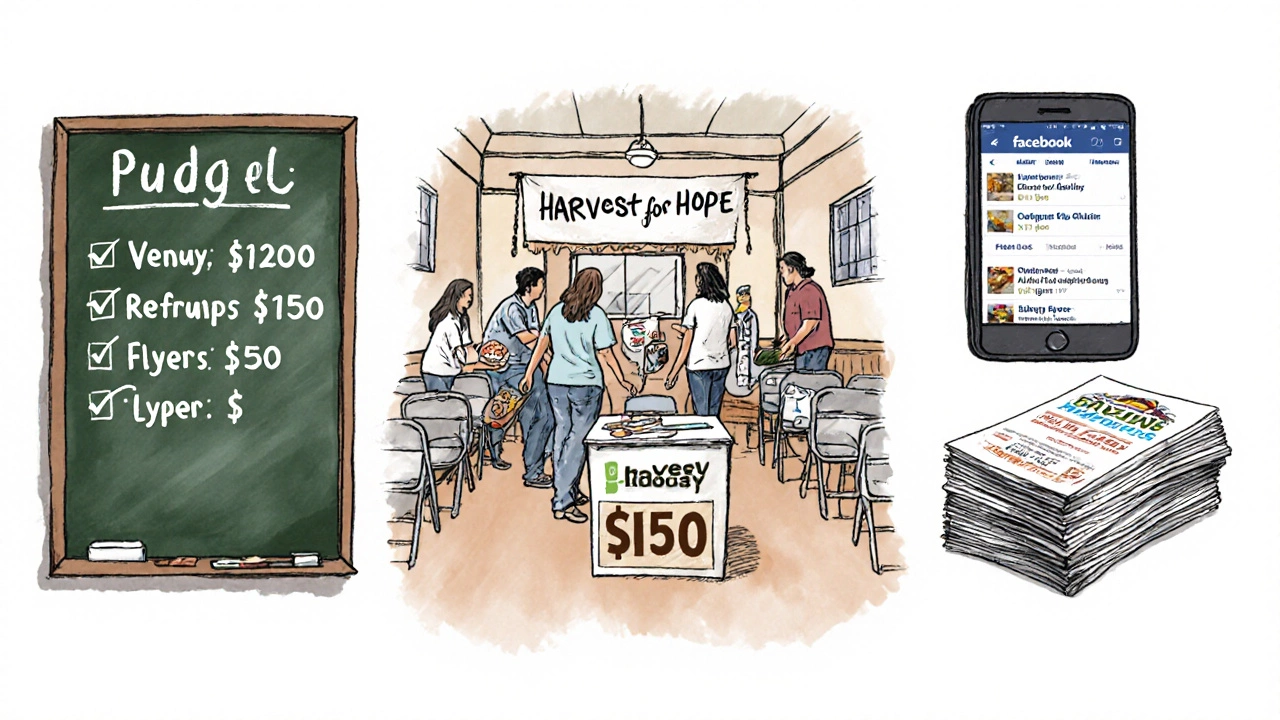Learn how to plan, budget, promote, and run a small charity event step by step, with real examples, checklists, and FAQs.

- Created by: Lydia Carmichael
- Completed on: 12 Oct 2025
- Categories: Events
Charity Event Budget Calculator
Estimate Your Event Costs
Enter your estimated costs for a small charity event to see if you're within a typical $500 budget range.
Planning a small charity event can feel overwhelming, especially if it’s your first time. The good news is you don’t need a huge team or a massive budget to make a real impact. By breaking the process into bite‑size tasks, you can turn a simple idea into a community‑driven fundraiser in just a few weeks.
Quick Takeaways
- Start with a clear, measurable goal for the event.
- Create a realistic budget and track every expense.
- Secure a free or low‑cost venue early.
- Recruit 5‑10 reliable volunteers and give them defined roles.
- Leverage local sponsors for in‑kind donations instead of cash.
- Use free social media tools and community boards for promotion.
- Set up a simple registration system to collect donations before the event.
- Run a day‑of checklist to keep everything on track.
Below is a practical roadmap that walks you through each step, includes real‑world numbers, and warns you about common pitfalls.
1. Define Your Goal and Cause
Every successful event starts with a single question: What are we trying to achieve? Write down a specific target-e.g., “Raise $1,200 for winter coats for the Wellington homeless shelter” or “Gather 50 volunteers to plant native trees in the Hutt Valley.”
When you can state the goal in clear numbers, it becomes easier to design the rest of the plan. It also helps volunteers and donors see the direct impact of their contribution.
Charity event is a gathering organized to raise awareness, funds, or resources for a specific cause, often involving volunteer support and community participation. Think of it as a focused mission rather than just a party.
2. Build a Simple Budget
Even a modest gathering benefits from a written budget. List every expected cost and assign a realistic amount. Below is a typical $500 budget for a 50‑person event in Wellington:
- Venue (community hall or park permit): $200
- Refreshments (tea, coffee, snacks): $150
- Printed flyers and signage: $50
- Emergency buffer (last‑minute supplies): $100
Track the numbers in a spreadsheet and update them as you receive quotes or donations. If a local café offers free coffee, move that $150 to your “donation pool” for future needs.
Budget is a financial plan that outlines estimated expenses and expected revenue for an event, helping organizers stay within affordable limits.

3. Secure a Venue and Pick a Date
Free venues are the secret sauce for low‑cost events. Check with your local council, schools, churches, or cafés that often have community rooms available on weekdays.
When you contact a venue, ask for:
- Available dates that don’t clash with major holidays.
- Any hidden fees (clean‑up, security, insurance).
- Capacity limits and wheelchair accessibility.
For a small gathering, a Saturday afternoon in early autumn works well: the weather is mild, people are looking for weekend activities, and you can tie the theme to a “Harvest for Hope” fundraiser.
Venue is the physical location where the charity event takes place, ranging from community halls to outdoor parks, and it influences costs, capacity, and logistics.
4. Recruit Volunteers and Assign Roles
Most small events run on a team of 5‑10 volunteers. Post a short call‑out on community boards, Facebook groups, and the local library notice board. Emphasize the skill you need-e.g., “help with registration desk” or “manage food stations.”
Once you have volunteers, give each a clear responsibility and a brief written brief. Typical roles:
- Registration lead - checks in attendees, collects donations.
- Setup crew - arranges chairs, tables, signage.
- Refreshments manager - oversees food and drink.
- Promotion ambassador - shares live updates on social media.
- Cleanup coordinator - ensures the venue is left tidy.
Schedule a quick 30‑minute prep meeting a day before the event to walk through the timeline.
Volunteer is a person who gives their time and effort without monetary compensation, helping to run the event smoothly by handling specific tasks.
5. Find Sponsors or In‑Kind Support
Cash isn’t the only way to offset costs. Approach local businesses for in‑kind donations such as:
- Bakery: free pastries for the refreshment table.
- Print shop: discounted flyers.
- Gym: a free space for a fitness‑challenge fundraiser.
When you ask, be specific: “We need 30 cupcakes for a post‑event giveaway-could you provide them in exchange for a logo on our flyers?” Most small businesses love the community exposure.
Sponsor is an individual or organization that contributes money, goods, or services to support the event, often in exchange for brand visibility.
6. Promote the Event Effectively
Free digital channels do the heavy lifting for a modest budget. Follow this three‑step promotion plan:
- Create a compelling visual. Use Canva or a similar free tool to design a one‑page flyer with the event name, date, cause, and a clear call‑to‑action.
- Leverage community groups. Share the flyer on Facebook community pages, Nextdoor, and the Wellington City Council events calendar. Tag relevant local NGOs.
- Engage local media. Send a short press release to the community editor of the Dominion Post. Offer a quote from a beneficiary to increase chances of coverage.
Remember to include a short URL (e.g., bit.ly/WgtnCharity2025) so you can track where registrations come from.
Promotion is the set of activities designed to raise awareness and attract participants or donors, typically using social media, flyers, and local media outreach.

7. Manage Registrations and Donations
Even a small event benefits from an online sign‑up form. Google Forms, Eventbrite (free tier), or a simple Airtable base can collect names, email addresses, and optional donations.
Ask for a suggested donation amount rather than a fixed price-e.g., “We aim to raise $1,200, so a $20 contribution would help us reach that goal.” This method respects budgets while still encouraging generosity.
After people register, send an automated thank‑you email with event details and a reminder to bring a blanket if it’s outdoors.
Donation is a monetary contribution given by participants or supporters, often collected in advance through an online registration platform or on‑site during the event.
8. Day‑of Checklist and Smooth Execution
On the morning of the event, follow this concise checklist to keep everything on track:
| Time | Task | Owner |
|---|---|---|
| 08:00 | Arrive at venue, unlock doors | Setup crew |
| 08:30 | Arrange chairs, signage, donation box | Setup crew |
| 09:00 | Test audio/visual equipment | Tech volunteer |
| 09:30 | Welcome volunteers, review roles | Event lead |
| 10:00 | Open registration desk | Registration lead |
| 10:30 | Start program (speakers, activities) | Program coordinator |
| 12:00 | Refreshments break | Refreshments manager |
| 14:00 | Closing remarks, thank sponsors | Event lead |
| 14:30 | Break down, clean venue | Cleanup coordinator |
Schedule is the chronological plan of activities for the event day, detailing when each task should happen and who is responsible.
After the event, send a quick post‑event email summarizing the amount raised and sharing photos. Thank volunteers and sponsors personally-this builds goodwill for future projects.
Checklist Table for Quick Reference
| Step | Key Action | Tools/Resources |
|---|---|---|
| Goal | Set a measurable fundraising target | Google Doc, SMART framework |
| Budget | List all costs, track spend | Excel spreadsheet |
| Venue | Book free community space | Council website, phone call |
| Volunteers | Recruit 5‑10 people, assign roles | Facebook groups, sign‑up sheet |
| Sponsors | Secure in‑kind donations | Email template, local business list |
| Promotion | Design flyer, share online | Canva, Nextdoor, bit.ly |
| Registrations | Set up Google Form, collect donations | Google Forms, PayPal |
| Day‑of | Follow schedule, run checklist | Printed timeline, volunteers |
Frequently Asked Questions
How far in advance should I start planning?
A six‑week runway works well for most small events. It gives you time to lock in a venue, recruit volunteers, and run a focused promotion campaign without burning out.
What is the cheapest way to advertise?
Leverage free digital channels: community Facebook groups, Nextdoor, and the council’s event calendar. Pair these with a eye‑catching Canva flyer and you’ll reach a wide audience at zero cost.
Do I need insurance for a small gathering?
If the venue already covers public liability, you’re usually fine. However, for events with food or physical activities, a modest $150 public liability policy provides peace of mind.
How can I keep costs under $500?
Prioritize free venues, ask for in‑kind donations, and DIY your promotional materials. A $200 venue, $150 refreshments, $50 flyers, and a $100 contingency fits comfortably within that limit.
What’s the best way to thank donors after the event?
Send a personalized email that includes the total amount raised, a photo of the event, and a specific mention of each donor’s contribution. Hand‑written thank‑you cards to larger sponsors add a nice personal touch.